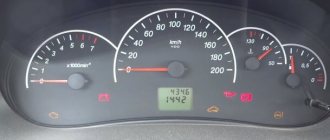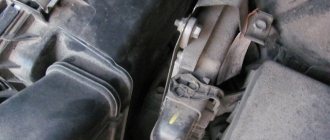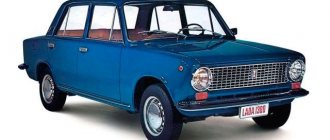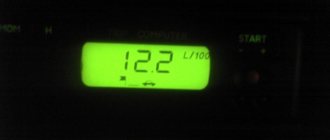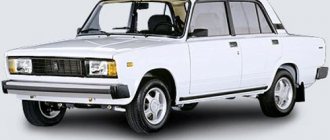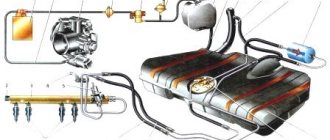The main indicator of economical operation of a car engine is specific fuel consumption. There are several methods for determining it. Every manufacturer wants their cars to have this figure as low as possible. Therefore, the methods for determining gasoline consumption differ from one another. The Russian manufacturer represented by AvtoVAZ claims that the fuel consumption of the Lada Granta averages 6.7-7.7 l/100 km in the combined driving cycle. However, passport data does not always coincide with actual results.
How are fuel consumption standards determined?
Gasoline consumption is determined in laboratory conditions. There are special techniques for this. For example, in Europe, consumption is determined according to NEDC standards - the new European driving cycle. The standard was last updated in 1997. Its disadvantage is that the choice of vehicle and test conditions is at the discretion of the automaker. Instead of a new car, a run-in version of the tested model can be used and almost perfect conditions created for this (windows closed, air conditioning, headlights and MMC turned off, etc.).
To simulate driving in the city and on the highway, different testing times are selected. Special rubber and low viscosity lubricating oil may be used. The presence of these factors leads to the fact that gasoline consumption standards appear in the car's passport, which are far from the true ones. The American and Japanese methods are more stringent, so the documents indicate values that are close to objective. In some cases, if you buy a car with a passport consumption of 7.5 liters per 100 km, in reality it turns out that it consumes 10-12 liters. This figure may increase depending on the season, fuel quality, load, road and engine conditions and many other factors. Therefore, drivers themselves try to determine specific fuel consumption and take measures to reduce it.
The world's main methods for measuring the consumption of new cars
As we wrote above, there are several methods for measuring the average fuel consumption of cars. Let's tell you more about them.
NEDC
In Europe, the most commonly used cycle is the NEDC type, which was developed about forty years ago. This causes reproaches from experts who talk about the outdatedness of the method.
NEDC Algorithm Structure
The main features can be considered that manufacturers are allowed to use a selective method for selecting a machine. We are talking about the fact that for testing we provide cars with already run-in components, special lubricants of low viscosity, as well as with the most compact tires that can be installed on a car.
In addition, if desired, testing can be carried out with the radio, heating, and so on turned off. This allows you to “select” those results that would best suit the manufacturer.
Measurements are carried out in the urban (NEDC UDC) and suburban (NEDC EUDC) cycles. The length of the "urban test" is 780 seconds, while the suburban test involves a period of time equal to 400 seconds. In the first case, the average speed will be a little over 18 kilometers, and in the second - about 62.6 kilometers per hour.
This technique is criticized for the reason that many models with an additional electric motor can travel most of this short distance without using the internal combustion engine. This becomes the source of amazing results with extremely low fuel consumption, even in sports cars.
FTP-75
But these standards no longer meet market requirements, so manufacturers are increasingly turning to the American standard FTP-75. It is considered the closest to reality, although experts talk about problems with the lack of areas where movement occurs evenly.
FTP-75 algorithm speed dependence
It is similar to the European NEDC, including an average speed of 34.1 kilometers per hour. Another advantage is that the test duration is 1874 seconds, so it is more difficult for hybrid car models to show “unrealistically low” fuel consumption figures. But what is most important is that the American version of the test obliges manufacturers to include air conditioning if it is included in the package.
As a result, fuel consumption in this test is higher than in NEDC by 10 or even 20 percent.
Japanese cycle JC08
In the case of JC08 the difference will be even greater. The fact is that in it the number of accelerations and decelerations is maximum, and there are no long sections with even speed parameters at all.
In addition, the maximum speed does not exceed 80 kilometers per hour. On one of the sections, the length of which is 8.2 kilometers, the average speed does not even reach 25 kilometers per hour.
The slowest known method for calculating average flow
Of course, we can talk about the severity of the test, but it takes into account the increased load on the streets, which is typical for the island country of Japan. In addition, drivers in most large cities around the world find themselves in such conditions. So, it is worth considering this technique as the closest to reality.
In general, there is no optimal testing method yet. The current options represent a compromise that automakers are trying to use to their advantage. Therefore, you should always try to take into account the specific technique that gave the results specified in the vehicle specifications.
What factors influence the fuel consumption of the Lada Granta?
Fuel consumption when driving under standard conditions depends on the following factors and is:
- driving - 60%;
- operation at full air conditioner power - 15%;
- driving on a cold engine - 12%;
- traveling with lights on - 5%;
- open windows at speeds over 50 km/h - 4%;
- low tire pressure - 4%.
Gasoline consumption on the Lada Granta may increase due to:
- low quality fuel;
- using tires that are not appropriate for the season;
- unsatisfactory condition of the engine and systems serving it;
- aggressive driving style;
- condition of the road surface;
- use of powerful additional electrical equipment;
- installing a trunk, air box or driving with a trailer.
In winter, when the engine warms up, fuel consumption increases by 1.5-2 liters. Driving around the city during rush hour significantly increases fuel consumption. In some cases, consumption can reach 15-19 l/100 km.
Using gasoline with a low octane number not only increases its consumption, but also leads to engine overheating.
Highway congestion
Driving around the city, as a rule, is seriously hampered by the abundance of cars on the streets. This constantly leads to traffic jams. As a result, engine operation requires more gasoline.
The situation is aggravated in winter and summer, when you also need to either heat the car interior or cool it.
In total, consumption can increase significantly under the influence of all the previously mentioned factors.
Fuel consumption of 8-valve engines
The first copies of the Lada Granta, which appeared in 2011, were equipped with gasoline injection engines models 11183 and 11186 with a volume of 1.6 liters and a power of 82 and 87 hp. respectively. The use of a power supply system with distributed injection and a lightweight connecting rod and piston group made it possible to achieve a reduction in consumption in all driving modes. With a combined cycle, the 82-horsepower Lada Granta has a gasoline consumption of 7.4 liters, and with the 11186 engine - 7.0 liters per 100 km. When driving in the city it will be 9.7 and 9.0 l/100 km, and on the highway - 6.1 and 5.8 l/100 km, respectively.
In fact, the fuel consumption of the sedan differs significantly from the official data: outside the city it is about 6.6 liters, and in the combined cycle - 8.5 l/100 km. Differences in fuel consumption largely depend on the operation of the vehicle under conditions that differ significantly from laboratory conditions (ground tests). The use of low quality fuel and lubricants makes a significant contribution.
Sedan and liftback body
The Lada Granta sedan went on sale in 2011 and immediately became a popular car model. The reason for this was the massive purchases of this particular car: two years after its release, every 15 purchased car was a Lada Granta sedan. Of the three known trim levels - Standard, Normal and Luxury, the most affordable option is the standard. The engine capacity is 1.6 liters and the power is 82 hp. With. makes this 4-door model not only a budget, but also a practical economy class car. And the average gasoline consumption of the Lada Granta sedan is 7.5 liters per 100 kilometers.
Before the release of the new Lada model, many became interested in how much it would change. As a result, the technical characteristics of the liftback are not very different from the sedan. This car entered the market in 2014. The main changes are visible in the exterior of the car and in the 5-door configuration. Other functional devices remained the same or were improved. The lack of changes can be seen on the car configuration, which was transferred from the Grant sedan. Fuel consumption in such cars is slightly higher, as engine power has increased.
Fuel consumption of 16-valve engines
Installing 4 valves per cylinder made it possible to reduce the load on the engine, which had a positive effect on reducing fuel consumption and at the same time increasing the power of the power unit. The cars were equipped with engines 21126 (98 hp) and 21127 (106 hp) with a volume of 1.6 liters. Frets with such engines had both a mechanical and a robotic gearbox. According to the passport data, fuel consumption standards per 100 km for cars with a 98 hp power unit. are:
- urban cycle - 9.9 l;
- highway - 6.1 l;
- mixed cycle - 7.6 l.
Despite the fact that the 21127 engine has more power, it consumes slightly less fuel:
- city roads - 8.6 l;
- highway - 5.6 l;
- mixed cycle - 6.7 l.
Actual costs differ from the passport costs and amount to 10-12 liters for the city and 7 -7.5 liters when driving on suburban highways.
LadaGranta 1.6 (87 hp)
The car is equipped with 1.6-liter engines that develop a power of 87 horsepower and are equipped with a five-speed manual transmission. Torque of 140 Nm helps the Lada Granta accelerate to 180 km/h.
Reviews of fuel consumption Lada Granta 1.6 (87 hp)
- Valery, Sevastopol. Lada Granta 2015, 1.6, manual transmission. I bought it new from the showroom and am pleased with the service and the car, which has a memorable appearance. I deliberately did not take the minimum power, but not the greatest either. As it turned out, the 1.6 engine with 87 “horses” consumes from 6 liters of fuel on the highway to 10 liters in the city.
- Ilya, Tolyatti. For our small family, the Lada Granta came in handy. You can drive around the city, go out of town, and go into nature. The handling is quite comfortable, and the wife is happy with the large trunk. The 1.6 engine (87 mares) requires an average of 8 liters of fuel.
- Konstantin, Moscow. We took the 2012 Lada Granta from the showroom, since it was not a cheap purchase, we hoped for long service, but as it turned out, the car disappointed us. If there were any advantages to it, it all broke down very quickly and required repair. Glad we finally sold. Fuel consumption was 6-9.5 liters.
- Igor, Omsk. Lada Granta, build 2014, 1.6, MT. The car is very good, unpretentious and manageable. During the year of ownership I replaced only consumables. And also economical, which is important, 6-10 liters per hundred is a good indicator.
- Vsevolod, N. Urengoy. I have a 2013 Lada Granta, 1.6 manual. For the first six months I was amazed at this creation of our automobile industry, you feel so good behind the wheel! The suspension smooths out road irregularities well. And the consumption is low: 5.5 on the highway, up to 9 liters in the city.
- Peter, Petersburg. I am the owner of a 2015 Granta with a 1.6 engine of 87 hp, MT. After driving for the first two months, I had a strong impression of it as the best car ever created in our native lands. And you don’t need a lot of gasoline: from 6 liters on a country highway to 9.5 liters in the city.
- Philip, Anthracite. Lada Granta 2013, 1.6, manual transmission. In the first six months I drove 20,000 km, and I can confidently say that the car is very good. Comfortable interior, large trunk, obedient steering wheel and unpretentious repairs. Consumption is very small: on average, about 7 liters.
- Evgeniy, Syktyvkar. I got the 87-horsepower version of the 2014 Lada Granta. Everything in the car suits you, it feels the road well, and the suspension allows you to feel comfort that is unprecedented for domestic cars. The amount of gasoline required is as written in the passport: 6-9 liters.
Features of consumption depending on the gearbox
Cars with an automatic transmission (automatic transmission) consume more fuel than those with a manual transmission (manual transmission).
This is due to the fact that the robot switches gears with a delay, i.e., to switch to a higher gear, higher engine speeds are required than with a manual transmission.
This is especially noticeable when driving within the city. Gasoline consumption for cars with automatic transmission in this case is 11-12 l/100 km. On the highway, these figures are slightly lower and fluctuate between 7.5-8.5 l/100 km. In winter, gasoline costs increase by 2-2.5 l/100 km. On cars with a manual transmission, fuel consumption under the same conditions is 2-3 liters less.
Due to the high cost and high fuel costs, cars with a robotic gearbox are in less demand among potential Lada Granta owners.
Driving style
Fuel consumption also largely depends on it. Fans of speed and spectacular starts with sudden stops spend more fuel than calm car owners.
Moreover, when the driver constantly starts with a cold engine, the amount of gasoline burned usually increases by approximately 12 percent.
As previously noted, the operation of various electronic systems, including air conditioning, also requires fuel. The more gadgets and gadgets installed on a car, the more difficult it is to save gas.
Only one air conditioner can “eat” an additional 15 percent of the total volume.
How to measure fuel consumption yourself
On car enthusiast forums you can often find messages that their Ladas consume from 14 to 18 l/100 km when driving around the city or 8-9 l when driving outside the city. Despite the presence of an on-board computer, many car owners try to calculate specific fuel consumption themselves. It happens that the result is less than the computer readings, and sometimes vice versa. In this case, you must contact a service station to diagnose the engine.
Test lamp method
To ensure accurate fuel consumption measurements, you must drive at least 1 thousand km. When the minimum fuel reserve warning light comes on, less than 7 liters of gasoline remains in the tank. The car is filled with fuel until the gas tank is full. After this, the odometer is reset, and the car is operated in everyday mode until the light comes on. The car is filled with AI 95 gasoline and so on until the mileage is 1 thousand km. After the next signal lights up, readings are taken and the average fuel consumption is determined.
The calculation is carried out using the formula: (V/L)x100, where V is the total amount of gasoline filled, and L is the control mileage of the car. If the result differs from the passport data and exceeds 10 liters, check the serviceability of the systems. To do this, the on-board computer readings are reset and a test drive is carried out on an open road at a constant speed of 80-90 km/h.
The mileage per trip should be 5-10 km. If, as a result of measurements, the consumption according to the on-board computer is in the range of 4.5-5.5 liters, it means that the engine is working normally, and the increased fuel consumption is associated with driving style or the congestion and condition of the roads. Otherwise, you need to contact a car service.
From tank to tank
With this method of determining the average fuel consumption, the result is less accurate than in the previous one, but it will qualitatively show the excess or value of the specified fuel consumption. To do this, the odometer and computer readings are reset, and the fuel tank is filled up to the neck so that the gasoline level is visible. The vehicle must travel at least 300 km in various modes. The longer the mileage, the more accurate the result will be.
After all the gasoline has been used up, the car is refueled to the same level as before taking measurements. The average consumption is determined by the same formula as in the previous case. The calculated data is compared with computer readings. If the difference is large, then it is necessary to check the readings and, if necessary, calibrate the fuel consumption on the device.
Measurement results may vary due to the quality of gasoline. Therefore, it is recommended to carry out measurements while replenishing fuel at one gas station. In case of increased consumption, you need to measure it while refueling at a gas station of another network.
Factory settings
There are certain methods for determining the average fuel consumption of a car engine. By the way, they are approved by law. The car is not tested at testing grounds, but is driven to special laboratories with “ideal” conditions. Next, the wheels of the car are installed on the drum, which simulate urban and suburban operating conditions. That is why, in most cases, the actual consumption does not coincide with the factory one.
Let's add to this the factor that the driving style is different for most drivers.
Factors affecting fuel consumption
Fuel consumption of 8 valve engines
The data is presented for Lada Granta cars equipped with a manual transmission.
| Engine (model) | Engine power (hp) | Engine capacity (cc) | Fuel consumption in the urban cycle (l/100 km) | Fuel consumption outside the city (l/100 km) | Combined fuel consumption (l/100 km) |
| 11183 | 82 | 1596 | 9.7 | 6.1 | 7,4 |
| 11186 | 87 | 1596 | 9 | 5.8 | 7,0 |
| 21116 | 87 | 1596 | 9 | 5.8 | 7,0 |
Read more about the most common engine in the Lada Granta 21116 line here.
Fuel consumption of 16 valve engines
The data is presented for Lada Granta cars equipped with a manual transmission.
| Engine (model) | Engine power (hp) | Engine capacity (cc) | Fuel consumption in the urban cycle (l/100 km) | Fuel consumption outside the city (l/100 km) | Combined fuel consumption (l/100 km) |
| 21126 | 98 | 1596 | 9.9 | 6.1 | 7,6 |
| 21127 | 106 | 1596 | 8.6 | 5.6 | 6,7 |
As can be seen from the tables, the consumption of 16-valve engines is slightly lower than 8-valve engines. And the version with a powerful engine costs more. Therefore, we want to ask your opinion which engine is better.
All tests are carried out on 95-octane gasoline; all Lada Grant engines are designed for this octane number.
How does it go and, most importantly, where?
Grant is not a champion on the race track. It does not shine with refined handling on the “parquet” floor. Here it is reliable in taxiing, but no more. But in Russia there are few truly smooth roads. To understand Granta's abilities, we need to shift the coordinate system. How to compare a car with a ground clearance of 195 mm in running order and 160 mm when fully loaded? Yes, with a single-wheel drive crossover!
The Granta has an almost impenetrable suspension, excellent ride quality on crushing and undulating surfaces, excellent cross-country ability for a single-wheel drive and very good handling for such a tall passenger car, and even with high-profile tires.
Got in and drove off or what?
There are things that I recommend doing right away. It is advisable to check the wheel alignment without delaying
. I had no questions about the pre-restyling car - I drove it without problems with the wheels up to 50,000 km. But the updated liftback and similar Grants from friends were slightly eating away at the outer part of the tread on the front tires. Exactly so much that it can be attributed to the imperfect quality of cheap tires. Indeed, the steering wheel is straight, the car does not pull anywhere while driving, the run-out is good, and fuel consumption is low. But I stopped by to check so as not to guess on the coffee grounds. The officials announced about five thousand rubles for the operation! Result: caster and camber are normal. Moreover, the parameters for the left and right wheels have very minimal discrepancies. The problem was with the toe-in - a slight fall out of the tolerance range. Simply put, the wheels were spinning a little. The shoes have been rehabilitated. I understand that two new 14-inch Artmotion tires from Belarus will cost less than checking wheel alignment angles from the officials. But there is also a winter set.
I’ll mention a couple of very useful and inexpensive modifications that are best done in the first days of operation. The first is a self-adhesive seal for the gap between the upper edge of the windshield and the roof
(pictured above).
In this area, the paint is highly susceptible to abrasive wear. The second is cheap plastic tubes for upgrading the seals of the sliding windows
. Grant has one drawback - the slightly open windows rattle unpleasantly in the openings. The tubes are pushed into the seal and the itching disappears. The modification does not interfere with the operation of the power window.
Seasonality
The most expensive car is in winter and summer. Moreover, it is more difficult precisely in the cold season, because in the heat the owner only needs to monitor the engine temperature and the operation of the air conditioner. In cold weather, other factors also influence consumption:
- winter tires;
- heating;
- heated mirrors and rear view glass;
- the need to drive as carefully as possible, etc.
In the modern world, where the price of fuel is constantly rising, it is necessary to think about how to save on your movement. Giving up the car is not an option, but trying to reduce fuel consumption, in particular on the Lada Granta, can be considered an acceptable option. This is exactly what we will talk about today.
Vehicle equipment
A very significant factor when taking into account the consumption of a Lada Grant is the vehicle’s equipment; here it is important to understand that by vehicle equipment we mean all sorts of variations in the assembly of the model, such as different bodies, engines, mechanical parts and electronic equipment, officially presented by the manufacturing company.
For example, “Granta Sedan” and “Granta Liftback” are available in three versions with 98/87/106 HP engines, gasoline consumption per 100 km of the Lada Granta is 7.8/7.2/6.9 liters, respectively, and the fuel consumption of the Lada Granta 8 valve is 7 .2 – with an 87LS engine, while the other two configuration options 98LS and 106LS are represented by 16 valve engines.
The situation is slightly different in the Granta Sport model, although the engine displacement of this car does not differ from other trim levels (1.6 liters), in this version of the car there is a noticeably increased power of 118 HP, the engine also has 16 valves for circulating the fuel mixture and a 5-speed gearbox. gearbox
An interesting fact regarding the Granta Sport is that, according to the manufacturer, the gasoline consumption of the Lada Granta Sport is only 6.8 liters per 100 km - which, apparently, is the smallest figure among all the above-mentioned trim levels.

